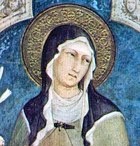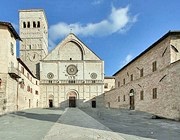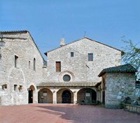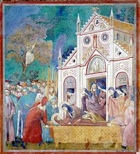


Detail of a fresco (ca. 1317) attributed to Simone Martini
Cappella di San Martino, San Francesco, Assisi
An entry in the Roman Martyrology under 11th August reads: “At Assisi in Umbria, the birthday of St Clare, virgin, the first of the Poor Ladies of the Order of Friars Minor. Being celebrated for holiness of life and miracles, she was placed among the holy virgins by Pope Alexander IV. Her feast, however, is observed on the day following.”
St Clare (Chiara di Favarone di Offreduccio) was born in Assisi in ca. 1194. She was probably christened in the earlier church of San Rufino, at the font that now stands in the right aisle of its successor.

When St Clare attended the Palm Sunday service at San Rufino in 1211 (or perhaps 1212), she modestly refrained from joining the rest of the congregation in a procession to receive the traditional palm leaves from Bishop Guido I. He therefore approached her and placed a palm leaf in her hand. The precise significance of this gesture is unclear, but it might have been a pre-arranged signal approving her plan. In any event, that night she left home and joined St Francis and his brothers at the Portiuncula.
St Francis received St Clare into the religious life by cutting her hair and giving her a rough habit to replace her fine clothes. He then took her to the Benedictine monastery of San Paolo delle Abbadesse near Bastia (which later moved to Assisi and ultimately became San Giuseppe). The Abbess protected her from her furious family, but she found it expedient to transfer her to the community of female penitents at Sant Angelo in Panzo on Mount Subasio. Finally, Bishop Guido I agreed that she and a few followers (including her sister, St Agnes) might live at San Damiano.
Life at San Damiano

Bishop Jacques de Vitry wrote in 1216 about "Fratres Minores et Sorores Minores" (Lesser Brothers and Lesser Sisters) that he had come across during a visit to Perugia. The women lived in hospices near the cities, "accepting nothing, living by the work of their hands". This testimony suggests that the community at San Damiano was one of a number that formed in the area under the inspiration of St Francis.
The sisters initially lived at San Damiano under a simple form of life that St Francis wrote for them. However, the Fourth Lateran Council (1215) forbad new religious orders, and the form of life that Jacques de Vitry had witnessed would soon be impossible. The community at San Damiano would soon have to accept a form of the Benedictine Rule, under which St Clare would be designated as the abbess of a cloistered community. Just before his death in Perugia in 1216, Pope Innocent III sugared the pill by issuing a Bull in which he declared that nobody could compel the community at San Damiano to accept property. St Clare was to spend the rest of her life fighting to keep this precious and unprecedented "privilege of poverty".
St Clare's vocation revolved around contemplative devotion to "the God Who was placed in a poor crib, lived poor in the world, and remained naked on the Cross" (Testament of St Clare, paragraph 45). Clausura did not directly threaten this central aspect of her new life, but it did make it more difficult to maintain contacts with the Franciscan brothers on whom she depended for spiritual and (now that the sisters could not solicit alms directly) for material support.
This problem was compounded by St Francis' increasing concern that the brothers should not be distracted by the growing number of female communities that professed a Franciscan vocation. Indeed, the first Visitor appointed for San Damiano in ca. 1218 was a Cistercian. While St Francis was away in the Egypt in 1219-20, Cardinal Ugolino (later Pope Gregory IX) appointed Brother Philip as Visitor to San Damiano. (Philip had been close to St Clare ever since her conversion, and the appointment might well have been at her request.) However, St Francis revoked the arrangement when he returned to Italy.
St Francis rarely visited San Damiano after 1212. However, he did so in 1225 to take his leave of St Clare, probably fearing that he would not survive a proposed journey to Rieti for much needed medical treatment. In fact, his condition suddenly deteriorated and he was forced to spend the next few weeks at San Damiano, sleeping in a hut in the garden. It was during this stay that he composed the Canticle of Brother Sun.

St Clare's sense of isolation must have intensified at this point. The Franciscans found it difficult and sometimes uncongenial to provide for the sisters, and they must often have gone hungry. However, she had the comfort of her family: her mother, the widowed Ortulana, her sister Beatrice and her aunt, Buona Guelfuccio (Sister Pacifica) joined her at San Damiano (at an unknown date) and she corresponded with her sister, St Agnes, who had been sent to form a new community at Santa Maria di Monticelli outside Florence in 1219. She also corresponded with the indefatigable Agnes of Prague, the daughter of King Ottocar I of Bohemia, who became Abbess of a Damianite community in Prague in 1230. Finally, she had the other sisters at San Damiano; their accounts during the process of canonisation (see below) give a palpable impression of the close and supportive community that St Clare created.
Assisi, like the rest of Umbria, suffered during the war between Gregory IX and the Emperor Frederick II. The unprotected location of San Damiano made it particularly vulnerable, and a band of Saracens in the Imperial army attacked it in September 1240. The sisters were terrified, but the soldiers withdrew when St Clare appeared before them carrying the Eucharist. Danger returned in 1241, when Vitalis d Aversa laid siege to Assisi itself on behalf of the Emperor. However, a great storm dispersed the attackers in response to the prayers of St Clare and her sisters.
Order of San Damiano
As noted above, San Damiano was one of a number of female religious communities that formed in the early 13th century, often in response to the preaching of the Franciscans and other mendicant friars. Cardinal Ugolino, as papal legate in Lombardy, Tuscany and Umbria in 1219, felt that many of these lacked appropriate spiritual and administrative guidance. He therefore arranged for Pope Honorius III to place them all (including the community at San Damiano) under direct papal control.
Soon after, Cardinal Ugolino drew up a form of life that was specifically designed to harmonise the practice of a group of "poor cloistered communities", a term that implied the emergence of a discrete religious order. There was nothing specifically Franciscan about this rule, and indeed (as noted above) the first Visitor that he appointed for San Damiano was a Cistercian. However, he frequently recruited sisters from San Damiano for responsible positions in the other communities, a policy that ensured the stamp of the Franciscan vocation upon them. In 1228, a few months after he was elected as Pope Gregory IX, he appointed Cardinal Rinaldo dei Conti Segni (later Pope Alexander IV) as Cardinal Protector of the both Franciscans and the Damianite communities.
Ugolino deeply respected St Clare and maintained an affectionate correspondence with her both before and after his elevation to the papacy. He therefore agreed to confirm the privilege of poverty for San Damiano in 1228. He also (very reluctantly and under pressure from St Clare) granted a similar privilege to a few of the other communities, including that of Agnes of Prague in 1238. However, these were exceptions, and he more usually went to great lengths to ensure the endowment of the various communities, particularly since the Franciscans were increasingly reluctant to do provide for them. He sometimes insisted that they should accept gifts that they wanted to turn away, and in other cases he specifically arranged endowments himself.
The Order of San Damiano became officially Franciscan in 1247, when Pope Innocent IV imposed a new form of life that transferred the duty of care from the Cardinal Protector to the Franciscan Minister General . While St Clare must have relished this formal link to the Franciscan Order, she was greatly pained by another aspect of the new form of life: it explicitly allowed the communities to have properties and revenues. In addition, the transfer of responsibility to the Franciscans was hard to enforce while the Pope was in exile in Lyons, and from ca. 1250, Cardinal Rinaldo re-emerged as Cardinal Protector of the Order.
Tired of all this, St Clare wrote her own "Way of Life for the Order of Poor Sisters established by St Francis" in ca. 1252. Cardinal Rinaldo immediately approved it, but St Clare pressed for formal papal approval. She received the Bull conferring this on 9th August 1253, and died with it in her hands two days later. (The original rule was discovered in 1893 in a mantle that had belonged to St Clare: both are preserved at Santa Chiara.)
St Clare's rule applied only to her own community. In imposing it, she had in effect withdrawn her sisters from the Order of San Damiano.
Death and Canonisation of St Clare
In August 1253, it became clear that St Clare was dying. Innocent IV visited her at least twice during her final illness. Brothers Leo, Angelo and Juniper (all of whom had been among St Francis' early followers) attended the death bed, and St Agnes returned to San Damiano from Florence. Another of the sisters (Benvenuta) had a vision in which the Virgin and other virgin saints appeared around the dying St Clare, as if welcoming her into Heaven.
When St Clare died, the Podestà placed an armed guard on San Damiano to protect her body. Innocent IV and the Curia arrived for the funeral on the following day. Innocent IV wanted to canonise St Clare on the spot by reciting the Mass for a Holy Virgin, but Cardinal Rinaldo objected that a proper canonisation process was needed. Innocent IV therefore celebrated the traditional Office for the Dead before leading the procession in which St Clares body was carried from San Damiano at San Giorgio.
Innocent IV appointed Bishop Bartolomeo of Spoleto to conduct the process for the canonisation of St Clare in October 1253. He died before the process was complete, and Cardinal Rinaldo, now Pope Alexander IV, duly canonised her at Anagni in 1255. In 1260, the Bishops of Perugia, Spoleto and Assisi translated the relics of St Clare from San Giorgio to a burial vault under the high altar of the sisters’ new church of Santa Chiara.




